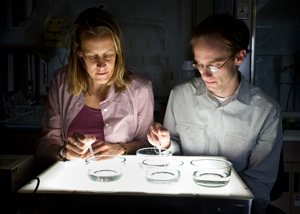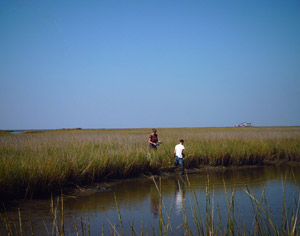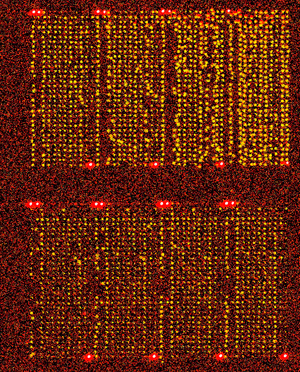Ann Tarrant has a soft spot for a tiny, tentacled creature. So what if starlet anemones (Nematostella vectensis) are spineless invertebrates that burrow in mud in stagnant brackish tidal marshes? To live there, they have to be remarkably adaptable to all sorts of changing conditions: big swings in temperature and salinity, for example, or sudden onslaughts of pollutants. Tarrant’s lab at Woods Hole Oceanographic Institution (WHOI) contains a nursery of glass dishes filled with Nematostella in all stages of their life cycle. WHOI postdoctoral fellow Adam Reitzel has collected anemones from Canada to Georgia and perfected methods to grow them in the lab. He and Tarrant know the anemone inside and out. Its entire genome has been sequenced, so they know every gene in its 1-centimeter-long orange body. And they have developed a method that reveals which genes are turned on to set in motion biochemical pathways that allow Nematostella to cope with stressful environmental conditions. Like, for example, a mammoth slug of light sweet crude oil from the blown-out Deepwater Horizon oil rig. Be prepared"Before this spill happened," Tarrant said, "we had developed a technique designed to probe responses of Nematostella to chemical stress. We had something sitting there ready to measure responses to chemical pollution in this animal." The scientists employ a technique called a DNA microarray, a small glass slide with a systematic arrangement of applied dots containing DNA. Each dot corresponds to a separate known gene from Nematostella. The microarray, developed by Tarrant with WHOI research specialist Jed Goldstone, can detect exactly which genes are expressed, or activated, to produce enzymes that detoxify pollutants and deal with other biochemical stresses stemming from the Gulf oil spill. With a National Science Foundation Rapid Response grant, Tarrant and Reitzel are collaborating with Matthew Jenny, a specialist in genetic sequencing and a former WHOI postdoctoral investigator who is now a molecular biologist at the University of Alabama. "We'll be looking for a fingerprint of how gene expression changes with oil exposure," Tarrant said. "What sorts of cellular systems are affected by oil? What molecular defenses do they have to metabolize and excrete oil compounds?" Nematostella may be low on the evolutionary tree of life, a "primitive" animal not very different from the earliest ones on Earth, but many of the genes and biochemical pathways it uses to metabolize contaminant chemicals are so fundamental that they have been retained in other invertebrates and vertebrates, including humans. "We think of Nematostella as much simpler than humans, but it has a similar number of these detoxifying enzymes,” she said. “We don't know what individual enzymes are doing and which will be activated." Synergistic stressesTheir research will test the responses of anemones under three sets of conditions, none of which have been studied before. In the first experiments, the researchers will use two different routes of contaminant exposure, through the water and through oil-contaminated food—brine shrimp reared in the presence of oil. ("Nematostella's not picky!" said Tarrant. "They'll eat oil-laced brine shrimp.") Chemicals introduced through the skin and digestive system may activate different genes and have very different effects, she said. Second, Tarrant thinks that the use of dispersants to help clean up the spill could magnify the oil's toxicity, so they'll study Nematostella kept in seawater containing oil alone or oil with dispersant. "If the dispersants do their job and disperse oil in the water, they make the oil potentially much more available to organisms living on the bottom or in the water," she said. "We expect dispersants could make the actual dose to organisms much higher, and we'd see effects at much lower levels of oil." Third, the scientists will examine synergistic effects of oil and low oxygen. "Often with oil spills, as the oil moves on shore, it is decomposed by microbes," Tarrant said, "and that can consume the oxygen in the water. Organisms might be simultaneously exposed to low oxygen and contaminants, so we're looking at those interacting effects." A model animal"Nematostella is starting to be an exciting model," said Tarrant. "We like to think of it as a 'lab rat,' but Nematostella's also a real-world animal exposed to the stresses and challenges that other animals would face." Nematostella is closely related to reef-building corals, but much easier to work with in the lab, Tarrant said, and this research could uncover insights that help scientists understand potential impacts to coral reefs from oil pollution. "There's a lot of concern about how corals might be affected by oil and pollutants in areas where there's a lot of traffic by oil tankers,” she said. In addition, the work could help predict the recovery of salt marshes that have been soiled by oil. "A lot of animals live in salt marshes. Those animals are really important to the functioning of the marsh, and the marsh is a really important environment as a nursery for juvenile fish and small shrimp," said Tarrant. "We have a lot to learn in predicting how shallow-water communities could be impacted by oil spills and chemical contaminants." This research is supported by a National Science Foundation RAPID grant. Development of the Nematostella microarray was supported in part by the WHOI Ocean Life Institute Originally published: April 8, 2011 Last updated: March 26, 2015 | |||||||||||||||||||||||
Copyright ©2007 Woods Hole Oceanographic Institution, All Rights Reserved, Privacy Policy. | |||||||||||||||||||||||




